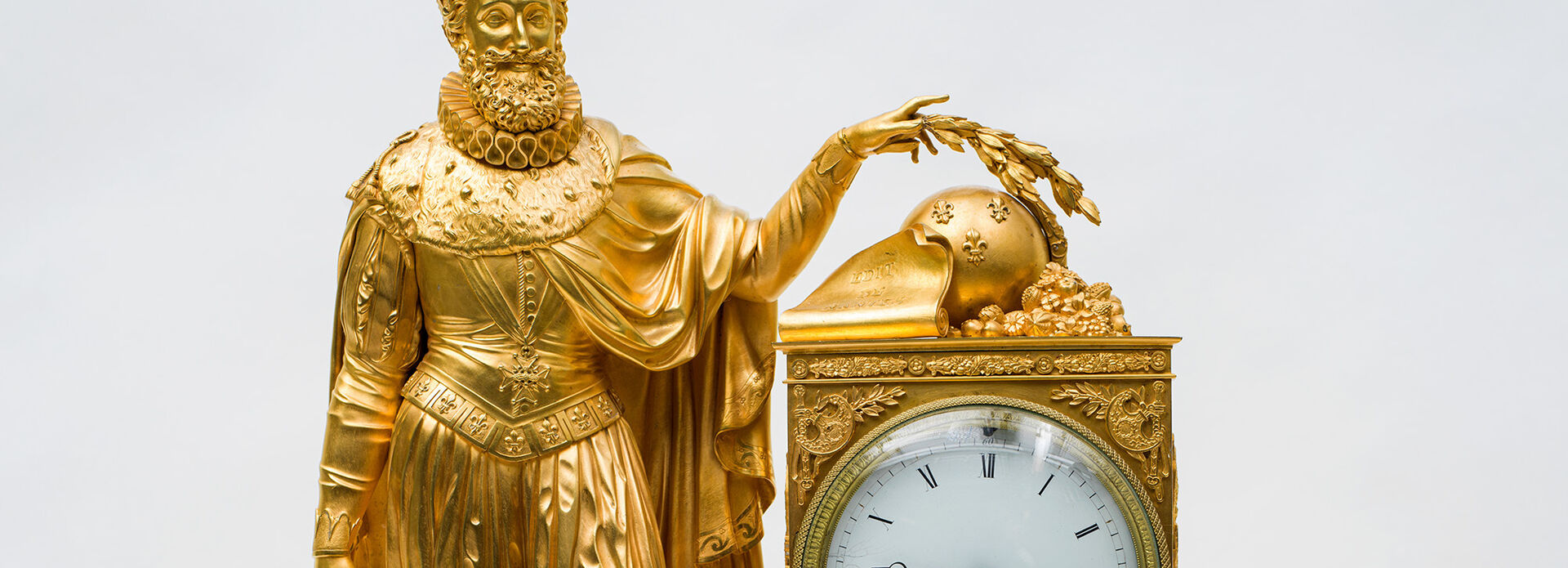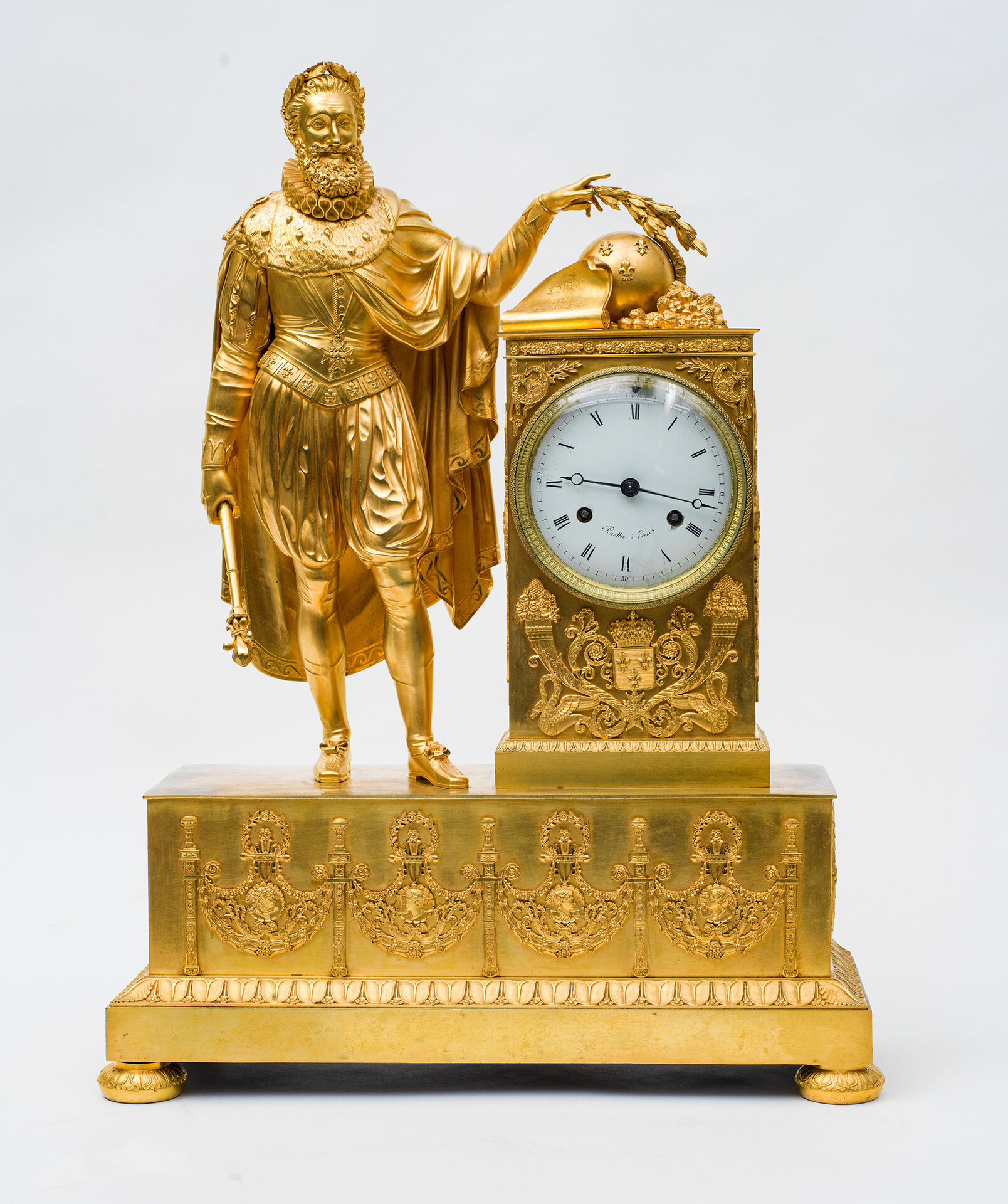Publicerad 2022-05-05
Nationalmuseum has recently acquired several significant French figurative table clocks dating from the early 19th century. These were an obligatory feature of the interior decoration style that developed during the Empire period, adorning many a mantelpiece and console table. Their primary function was not timekeeping, but rather to serve as covert but elegant propaganda for the French Empire and, later, for the restored Bourbon monarchy. They are described as figurative because the clock forms part of an ensemble including sculptures and decorative elements in gilt bronze.
A taste for bronze ostentation of this kind, which first developed in Paris in the second half of the 18th century, flourished in the Empire period. The luxury goods industry employed over 10,000 people in the French capital. For Napoleon, this was a source of pride for France, demonstrating its superiority to other European nations. But the emperor’s ambitions were equally motivated by economic gain: “Every time you beautify a palace, you should consider how this can benefit the arts and manufacturing.” The year after making this pronouncement, Napoleon launched the Continental Blockade. Although Britain was the target of this trade embargo, the French luxury goods industry was severely affected, and costly state subsidies were needed to prevent the Parisian bronze manufacturers from going out of business.
Prominent manufacturers included Antoine-André Ravrio (1759–1814), one of the bronze founders who had started out before the French Revolution of 1789. Despite difficulties during the revolution, he soon established a successful bronze foundry, specialising in gilt bronze. His table clocks often formed part of a set with other components such as candelabras, urns and perfume burners. The interior decoration style of the time prized the mass effect of brilliant metal artefacts placed in close proximity.
One of Nationalmuseum’s new acquisitions, Table Clock with Allegory of the Poet’s Art, dating from around 1810, is a product of Ravrio’s firm. It is made of gilt and patinated bronze, with a base of red griotte d’Italie marble. The clock features the well-known ancient Greek bust of Homer incorporated into a narrative tableau along with the Roman poet Virgil.
Ravrio often took inspiration from the classical world for both form and subject matter, but in other cases ancient Rome merely served as a disguise for the contemporary world. The anonymous maker of the table clock depicting Caesar made no attempt to conceal the fact that the figure was more like Napoleon than Caesar. Despite the 1814 regime change, table clocks of this kind seem to have been so popular that they remained in production, albeit with the eagles removed and replaced with a wreath of stars, as in this case.
In other cases, the figure of the emperor was simply switched out for the new regime’s mascot, King Henri IV of the House of Bourbon. In troubadour-style painting and the decorative arts, Henri was a popular figure, symbolising a return to the “good old days”.
The last of the figurative table clocks portrays another misfortune that befell the House of Bourbon. It features a tableau of Carolina, Duchess of Berry, with her newborn son Henri, Duke of Bordeaux, and her daughter Louise, saying their evening prayers. Atop the clock sits a weeping putto, reminding us of the absent father, the Duke of Berry, who was murdered seven months before his son’s birth. The infant duke, better known as the Count of Chambord, was a pretender to the French throne until his death in 1883. The clock was made by Jean-André Reiche (1752–1817), originally from Leipzig, who opened a bronze foundry in Paris in 1785.
“By acquiring these four superb figurative table clocks, all of which are outstanding examples of the French Empire style of interior decoration, we have significantly enhanced the museum’s collection of a genre that straddles the boundaries between sculpture and applied art, between art and politics,” said Magnus Olausson, head of collections at Nationalmuseum.
The newly acquired mantel clocks are on view in one of the galleries of 19th-century art at Nationalmuseum.
Nationalmuseum receives no state funds with which to acquire design, applied art and artwork; instead the collections are enriched through donations and gifts from private foundations and trusts. These acquisitions have been made possible by generous donations from the Axel Hirsch Foundation, the Sophia Giesecke Fund, and the Magda and Max Ettler legacy.
More news from Nationalmuseum
- Portrait of Honour 2025: Sarah Sjöström publicerat 2025-11-13
- Nationalmuseum in Stockholm acquires a painting by Sofonisba Anguissola publicerat 2025-09-16
- Portrait of Honour 2024: Max Martin by Mikael Jansson publicerat 2024-10-08
- A painting in the collections of the Nationalmuseum recently attributed to the famous artist Carel Fabritius publicerat 2024-05-22
- Embroidered appliqué by Britta Marakatt-Labba publicerat 2024-03-08

